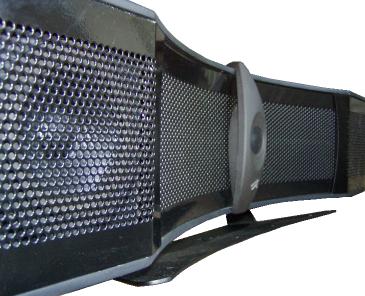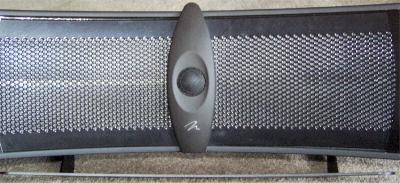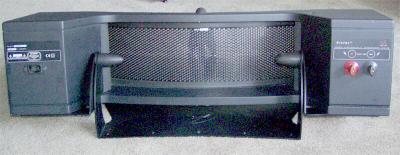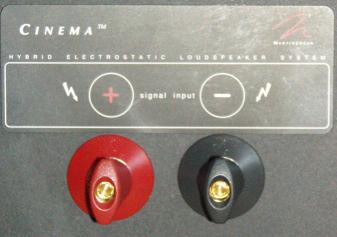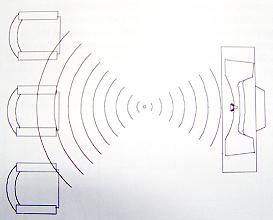|
|||||||||||||||||||||||
|
Introduction
Along with more exposure, Martin Logan has updated
their home theater line to include two center channel speakers: the Theater
and the Cinema. The Cinema has been around for a few years, and remains a
staple in Martin Logan's attempt at affordable home theater. Mated with a
pair of Ascents, or last years Aerius Is, an ML front stage can be had for
as little as $3,000. Of course this is not exactly home theater in a box
price, but it is cheap for a company that regularly produces $20,000+
speakers. Martin Logan makes a custom stand/mount that can (and should) be purchased for an additional $200, that allows the speaker to be angled or wall mounted (see photo of the Cinema sitting on my TV).
The speaker is a tough load to drive, listed at a
nominal 6 Ohms, but dipping to 3.7 Ohms at 20 kHz. The best match would be a
nice amplifier that can handle bursts of a 2 ohm load and constant output at
4 ohms. Something like the Sunfire Cinema Grand would be a great match, but
something like the Kenwood VR-407, or the aforementioned Sony Boom box would
not. Out of curiosity I hooked up this speaker and a pair of Aerius Is to a
Yamaha RXV-1000 receiver and nothing exploded. The volume had to be turned
way up to compensate, so I wouldn't recommend the strain it puts on a
receiver's amps. Newer receivers like the Yamaha RX-Z1, or the Denon 5803,
which are rated down to 2 ohms, might be able to handle the load. But I'd
speak to a local dealer before getting too ambitious.
The Cinema is not bi-wireable, unlike most of Martin Logan's other speakers, so speaker cables must be single-runs only. The binding posts themselves are Martin Logan traditions, very easy to tighten and loosen due to the large surface area. They accept spades or banana connectors, but NOT bare wire or pins. The power cord that comes with the Cinema is smaller than I would have liked – only six feet. When you figure many TVs and entertainment centers are well over five feet high, this does not leave much room for maneuvering.
The speaker is gigantic, bigger than almost any center
channel I've ever seen (although it is dwarfed by its sibling, the Theater)
measuring almost 34” wide and 8” high. The mounting bracket adds another 2”
in height and possibly more, depending on the angle at which the speaker
sits. Make some specific measurements before placing this on top of a TV, or
nestling it in an enclosed cabinet. The size is a factor to consider: 19”
TVs need not apply. The Cinema weighs in at a hefty 28 pounds, maybe too
much for many TVs to handle, so be cautious. I had to mount some brackets
that I purchased from Home Depot to the studs behind my TV just so the
weight didn't crush my 42” RPTV. From the listening position of directly in front of the speaker, i.e., my sweet spot, imaging was dead on and the speaker itself disappeared. Voices were spoken by the images on the TV, not from on top of the TV. Left to Right pans with the Aerius Is were seamless with no noticeable drop out where one speaker stops and another takes over. I set a pretty high crossover, as the mid-bass drivers are -3 dB at 80 Hz. I found that a crossover of 100 Hz with an equalizer setting of -1 dB at 120 Hz worked well with my SVS subwoofer. Since dialogue is the most important responsibility of a center channel, my testing consisted of dialogue-heavy DVDs like "Memento" and "Bridget Jones's Diary", along with simple Dish Network programming. I was looking for muddied phrases and times when I could not understand what was being said, but not surprisingly, I had a hard time finding any flaws with this speaker's performance. The midrange was so smooth and perfectly matched to my other electrostatics from ML that I was sold after only a few hours of getting it properly set up. I am still surprised at how smooth and transparent the speaker sounds, considering it has two crossover points (at 300 Hz and 3,500 Hz) and a different driver compliment than any other Martin Logan Speaker. The tweeter made very high frequencies sound crisp but not tizzy. When people spoke the letter “s” it did not ring out, but flowed with the rest of their sentence smoothly, like the person was there talking to me. And like all electrostatic speakers, there is no enclosure to give that claustrophobic hollowness that box speakers sometimes have. This speaker was all open and has that Martin Logan sound that has made them an audiophile super giant. Off Axis listening was a slightly different story. Because of the inward curve of the electrostatic panel, the sound forms a sort of hourglass shape in the room, with dead spots to the far right and far left of center. Martin Logan describes this in the manual as a way to broaden the soundstage for listeners seated in front of the TV (see picture). But in a smaller room, this “hourglass” could have the effect of creating a very large void. Although this too can be cured with speaker placement, listening tests are critical to determine if the speaker is in the best possible spot.
In my room, off axis seats did exhibit some of the
emptiness, sounding like the seat was in a frequency valley. I can live with
that slight problem, but some other consumers might have a hard time
adjusting the speaker because of it. The best solution is to buy from a
dealer with a return or exchange policy so that you can be sure it fits your
room. An easy cure for Martin Logan would be to curve the electrostatic
panel out toward the listener. This would result in an even dispersion of
sound throughout the room . . . and coincidentally, Martin Logan's top
center channel speaker, the Theater, does have the electrostatic panel
curved out so as not to create this same problem.
|
|||||||||||||||||||||||

